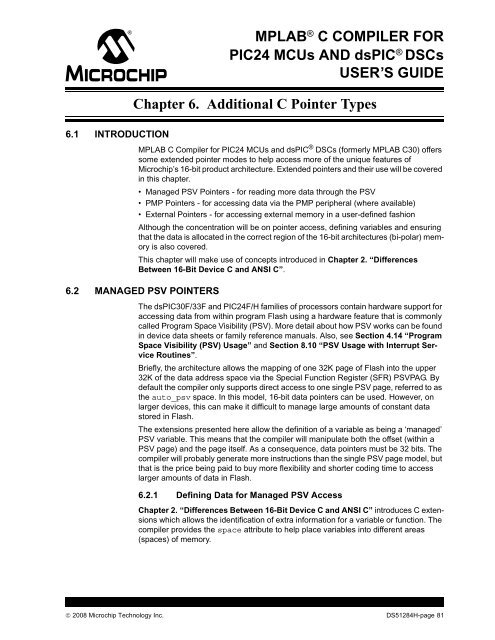MPLAB C Compiler for PIC24 MCUs and dsPIC DSCs ... - Microchip
MPLAB C Compiler for PIC24 MCUs and dsPIC DSCs ... - Microchip
MPLAB C Compiler for PIC24 MCUs and dsPIC DSCs ... - Microchip
You also want an ePaper? Increase the reach of your titles
YUMPU automatically turns print PDFs into web optimized ePapers that Google loves.
6.1 INTRODUCTION<br />
<strong>MPLAB</strong> ® C COMPILER FOR<br />
<strong>PIC24</strong> <strong>MCUs</strong> AND <strong>dsPIC</strong> ® <strong>DSCs</strong><br />
USER’S GUIDE<br />
Chapter 6. Additional C Pointer Types<br />
<strong>MPLAB</strong> C <strong>Compiler</strong> <strong>for</strong> <strong>PIC24</strong> <strong>MCUs</strong> <strong>and</strong> <strong>dsPIC</strong> ® <strong>DSCs</strong> (<strong>for</strong>merly <strong>MPLAB</strong> C30) offers<br />
some extended pointer modes to help access more of the unique features of<br />
<strong>Microchip</strong>’s 16-bit product architecture. Extended pointers <strong>and</strong> their use will be covered<br />
in this chapter.<br />
• Managed PSV Pointers - <strong>for</strong> reading more data through the PSV<br />
• PMP Pointers - <strong>for</strong> accessing data via the PMP peripheral (where available)<br />
• External Pointers - <strong>for</strong> accessing external memory in a user-defined fashion<br />
Although the concentration will be on pointer access, defining variables <strong>and</strong> ensuring<br />
that the data is allocated in the correct region of the 16-bit architectures (bi-polar) memory<br />
is also covered.<br />
This chapter will make use of concepts introduced in Chapter 2. “Differences<br />
Between 16-Bit Device C <strong>and</strong> ANSI C”.<br />
6.2 MANAGED PSV POINTERS<br />
The <strong>dsPIC</strong>30F/33F <strong>and</strong> <strong>PIC24</strong>F/H families of processors contain hardware support <strong>for</strong><br />
accessing data from within program Flash using a hardware feature that is commonly<br />
called Program Space Visibility (PSV). More detail about how PSV works can be found<br />
in device data sheets or family reference manuals. Also, see Section 4.14 “Program<br />
Space Visibility (PSV) Usage” <strong>and</strong> Section 8.10 “PSV Usage with Interrupt Service<br />
Routines”.<br />
Briefly, the architecture allows the mapping of one 32K page of Flash into the upper<br />
32K of the data address space via the Special Function Register (SFR) PSVPAG. By<br />
default the compiler only supports direct access to one single PSV page, referred to as<br />
the auto_psv space. In this model, 16-bit data pointers can be used. However, on<br />
larger devices, this can make it difficult to manage large amounts of constant data<br />
stored in Flash.<br />
The extensions presented here allow the definition of a variable as being a ‘managed’<br />
PSV variable. This means that the compiler will manipulate both the offset (within a<br />
PSV page) <strong>and</strong> the page itself. As a consequence, data pointers must be 32 bits. The<br />
compiler will probably generate more instructions than the single PSV page model, but<br />
that is the price being paid to buy more flexibility <strong>and</strong> shorter coding time to access<br />
larger amounts of data in Flash.<br />
6.2.1 Defining Data <strong>for</strong> Managed PSV Access<br />
Chapter 2. “Differences Between 16-Bit Device C <strong>and</strong> ANSI C” introduces C extensions<br />
which allows the identification of extra in<strong>for</strong>mation <strong>for</strong> a variable or function. The<br />
compiler provides the space attribute to help place variables into different areas<br />
(spaces) of memory.<br />
© 2008 <strong>Microchip</strong> Technology Inc. DS51284H-page 81

















